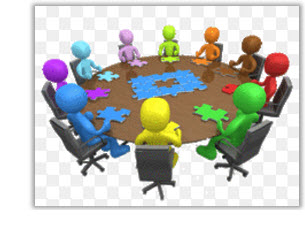 Looks like King Arthur was onto something.
Looks like King Arthur was onto something.
A new study by the University of British Columbia’s Sauder School of Business demonstrates the many team-building benefits of business-meeting attendees congregating in a circular fashion instead of an angular arrangement.
The study, as reported in smartplanet, provides insight into how something as simple as a meeting’s seating arrangement can dramatically affect the attitudes of the participants and, as a result, the meeting’s overall effectiveness.
Want more collaboration? Choose a round table or position chairs in a circle, thus avoiding any head-of-table status and the position of power inherent therein.
In contrast, angular seating arrangements position attendees in a hierarchical fashion with one or two meeting “leaders” and the rest in subordinate roles, regardless of the participants’ actual job titles. Such a configuration tends to make those in subordinate positions more defensive and less likely to feel their input will be received as truly collaborative.
“The geometric shape of a seating arrangement can act as a subtle environmental cue for people, by priming their fundamental need for inclusiveness or individuality,” said the study’s co-author, Juliet Zhu.
Study participants were grouped separately in either a circular (or oval) seating arrangement, or in an angular fashion.
They were then asked to share their opinions of various advertisements.
Those in the circular grouping responded more favorably to ads that depicted a sense of belonging, whereas those in the angular arrangement identified more strongly with ads depicting hard-charging individuals, i.e., those perceived as more maverick in nature.
From the report: “The study shows that people sitting in a circular formation are more likely to want to ‘belong’ to a group and are less prone to be antagonistic.
“People seated in an angular arrangement – i.e. ‘The Boardroom’ in Donald Trump’s The Apprentice – are more likely to look out for number one.”
Most working professionals spend lots of time in meetings. We probably can all agree that the ways in which meetings are conducted goes a long way toward either fostering a sense of unity or creating frustration.
In my many years working in creative environments for employers ranging from Internet startup to public agency to Fortune 500 corporation, I’ve participated in countless meetings. I’ve known for a long time that I prefer conducting meetings at round tables, but until now I never understood the innate psychological reasons that influence my preference.


